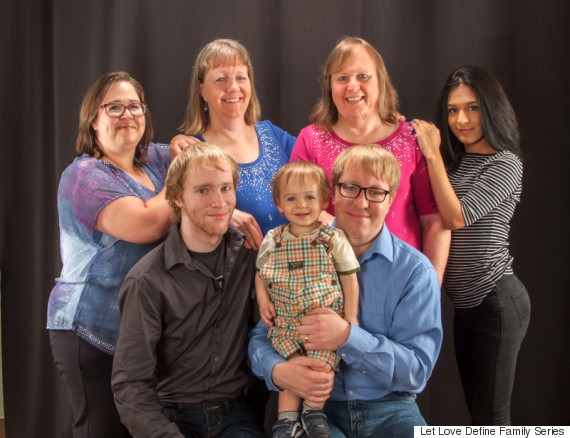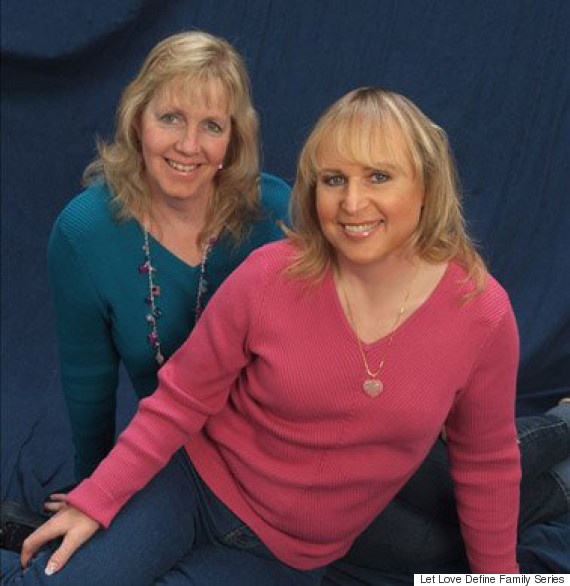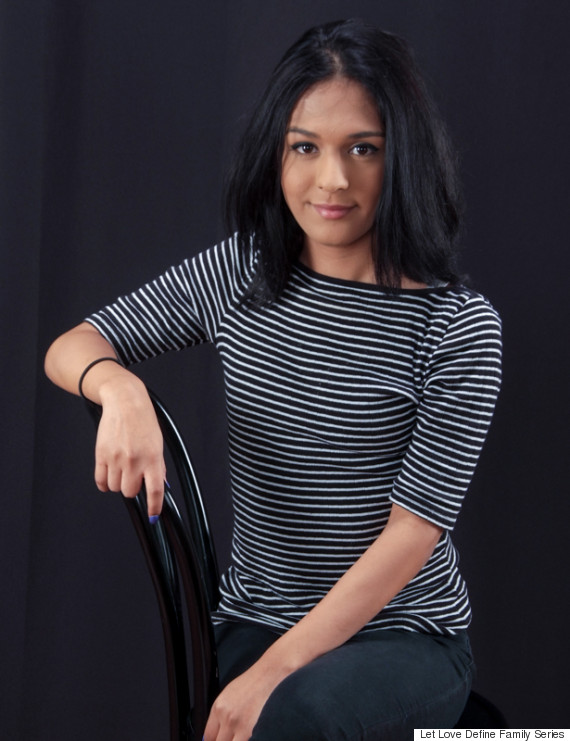Lauryn Farris' Story From The RaiseAChild.US Let Love Define Family Series
If there was ever a couple who truly Let Love Define Family, it’s Lauryn and Kerry Farris of San Antonio, Texas. Married as a cisgender straight couple nearly four decades ago, they remained in love and committed to one another as Lauryn transitioned to live and present as a woman, even during a five-year period while they were divorced. The parents of two biological sons, they became foster parents to a 17-year-old transgender girl who will join their family through adoption. On the eve of their day in family court, Lauryn spoke with RaiseAChild.US Founder and CEO Rich Valenza and contributing writer Beth Hallstrom about her life, faith, activism and expanding family.
Lauryn Farris: My name is Lauryn Harold Farris and I guess my middle name is Harold now because I was a junior and my father and my son both shared the same name.
My family today and my family tomorrow will be slightly different in that I’ve been married to the same woman for 33 years — we’ve been together 36 years. We have two biological boys, one 28 and one 22, and we have a foster daughter who is 17. Tomorrow, she becomes our adopted daughter.
Beth Hallstrom: That’s wonderful. Congratulations!
Farris: We’re also doing a name and gender change for her tomorrow. That’s pretty unheard of here in Texas for her age and with Child Protective Services, as far as we know. The only way to reissue a birth certificate in Texas is through adoption. So, we will get to reissue her birth certificate with not only her corrected name, but also her corrected gender markers.
Rich Valenza: That’s a big day tomorrow.
Farris: We’re also doing a dual adoption tomorrow — a joint adoption. There are more same-sex couples and families in San Antonio than any other city in the state.
Hallstrom: That’s fascinating. I wouldn’t have guessed that about San Antonio.
Farris: Most of the adoptions in the entire state are done in San Antonio, as are almost all name and gender marker changes. So, we’re really a pretty progressive city and one of the most equal. I was part of facilitating that back in 2013 when the city updated its non-discrimination ordinance to include sexual orientation and gender identity.
Valenza: What do you think makes San Antonio so liberal, accepting and inclusive?
Farris: We are a very Hispanic community and a very Catholic community. Much of our public community is very loving and much of our Catholic community has a “live and let live” attitude. When we get a lot of marchers together — there are a lot of freedom marches — all of these groups have welcomed the gay community.
I stood on the podium when we passed the non-discrimination ordinance with a Hispanic grandmother and Dominican nun who were supporting human rights. So, I think that’s why, but when you get outside the 410 loop in San Antonio, it’s a different world.

Valenza: Lauryn, you’ve mentioned religion a number of times. I’m curious about your faith.
Farris: I’m a pretty devout Christian and when people have real, true faith, they can move mountains. They don’t fear things like other people’s opinions. Many of the trailblazers in our community come from some very strong faith backgrounds and they continue with their faith even when rejected by the church.
That’s where the real strength comes from — from their faith. I believe what got our family through the transition was our faith.
Hallstrom: And do your children share your faith?
Farris: My younger son struggles a lot and he identifies as spiritual but non-religious at this point. But my older son is very active in the Metropolitan Community Church and our daughter has a strong belief in faith. When we began transitioning, one of the first things Kerry, my partner, and I wanted to do was come out to our minister.
One of my strongest memories of transitioning was having lunch with our minister as Lauryn. Kerry and I explained to him what was happening and who Lauryn was. The first words out of his mouth were, “You know you’ll never be able to take communion again,” then he turned to Kerry and said, “You and the boys are welcome any time.” I will never forget that.
Valenza: How did you get past that incident?
Farris: It was Mike Piazza [the progressive spiritual leader and former senior pastor and dean of the Cathedral of Hope in Dallas, Texas] who helped me break down the barrier that kept me from loving and accepting myself. Mike helped me understand that this is the way God made me and intended for me to be. Once I realized that, I realized that God would love me just the way I am. It was not a curse, it was a blessing.
This was before the meeting with our minister in San Antonio, while Kerry and I were divorced. Mike’s counseling helped me get past my alcohol abuse and allowed Kerry and I to re-marry.
Hallstrom: Did Kerry feel the same way?
Farris: Well, we’d been married a long time and Kerry knew about Lauryn before we were married. She didn’t really understand it. Thirty years ago it wasn’t like we could research it on the Internet! She thought I would change. Before the boys were born I went to cross-dressing groups and she was okay with that. I had an alcohol problem and it got worse and that’s when we actually divorced for five years. That’s when I worked with Mike Piazza, when I came out and within just a couple years, I was able to accept who I was. Then Kerry and I were remarried.
Within a few years of that, we made the decision to come out together. It was a big transition for Kerry and it took her awhile to get used to it. She doesn’t like to do public speaking, but she doesn’t mind talking about it at all. She tells her story and we just are who we are. We even remained close during the divorce. It’s destiny. There are so many reasons we shouldn’t be together but we love each other.
Valenza: Tell us about the girl you’re going to adopt. How did she come in to your life?
Farris: First, let me tell you how I got involved in the community. I got a call from a woman I know who said, “I know you’re transitioning and I really need your help. There’s a 17-year old transgender girl who lives out by you and I’d really Iike you to meet her. When she came out to her family, they told her to leave and never come back. She’s living on the streets and there are no shelters that will take her. She’s sleeping under a bridge and really struggling.”
So, I met her a few times. We would go to lunch and then, one Friday, I’ll never forget, she didn’t show up. I texted my friend asking if she’d seen her and, as far as I know now, no one’s ever seen her again. And I said, “Never again. I will never let this happen again to another transgender youth. I will do all in my power to prevent it.”

Hallstrom: Are there many transgender people in San Antonio?
Farris: We used to tell homeless people to go to Austin or Houston because there are shelters there that will let trans people live as trans people. Most shelters make people live based on their genitalia. Now, we have an LGBTQ shelter in San Antonio. I was involved with that even before it was open.
Hallstrom: Describe your involvement after your experience with the teen who disappeared.
Farris: I got really involved with helping at local homeless shelters. I got involved with Child Protective Services and its program Circle of Support. When a child turns 16, they put together a Circle of Support of people who will help support them when they age out of the system. I had met Catizia [their foster daughter] as a mentor and, at one meeting, they were really just yelling at her about her grades. She was failing every class and they couldn’t understand it.
I suggested we ask Catizia about her environment. She was going to a school outside that loop I spoke of — a very conservative school. She told stories about other students throwing water bottles at her and one of her teachers asking in front of the whole class, “So, does everybody know your little secret?” So, I got a little angrier and turned to the group leader and said, “Maybe she should come live with us!” 26 days later we were licensed as foster parents.
Valenza: What was it like in the beginning, after Catizia moved in?
Farris: She was seeing a counselor weekly. She had anger issues and she didn’t really know how to be what she was born to be. She was going back and forth to be able to survive in her previous living environment. If I mentioned she was transgender, it really upset her and she got angry.
Valenza: And today?
Farris: She sees her counselor once a month now and no longer has anger issues. She fully transitioned in the past year and we’ve been invited to media training conferences in Washington, D.C. Now she wants to tell her story whenever she can. Every semester at the [University of Texas] Health Science Center, she makes them cry with her story. She inspired a study of the transgender population in San Antonio and their health needs.
Valenza: With those you love, it’s worth the investment. You invested that time and love in your daughter and she’s made an amazing turnaround. How is your relationship with your sons?

Farris: My older son lives in San Antonio and he has my 21-month-old grand baby. He is an activist for the trans community and speaks often. My younger son graduated recently from college with a degree in psychology and wants to work with children. Our relationship, especially with my older son, is much better now. When I first came out he was angry because we were very close and he felt I had lied to him. We actually worked together on the non-discrimination ordinance and, when it passed, I lost it. I broke into tears and when I was walking out of the courthouse, there were news crews everywhere and he just stepped in front of me and took care of Mom. I think difficult situations are bonding opportunities.
With my immediate family, I think we’re closer now.
Valenza: That’s an amazing testament to what a loving family can do. I’m sure it wasn’t easy. You know, I came out late in life. I was 27 when I came out and my biggest fear was: would people still love me? Would I be accepted? I imagine it was the same if you had any fears when you made your transition. Was that the case?
Farris: I’ve thought a lot about this and I’ve written about it before. The transition of every transgender person I’ve met has been different. I’ve been involved in almost every national and local LGBT organization there is. One of the things I really believe is that each of us has our own individual barriers to self acceptance. To be able to love ourselves and truly accept ourselves — most of us have a barrier. For me it was faith.
I’ve talked about Mike Piazza before and I will tell you that at communion on that Easter Sunday when I was almost 40 and he said, “All are worthy, all are welcome,” that was the epiphany that broke my barrier and, at that time, I did not even realize that was a barrier for me. It wasn’t about people loving me — it was, would God love me? And what I realized was that God loved me just the way I was.
Hallstrom: Lauryn, you and your family have experienced quite a journey and evolution over the past 36 years. Looking back, what are your thoughts?
Farris: I think one of the great tragedies is that we transgender people, in the past, don’t typically come out until later in life. As trans people, we raise our children and then don’t come out until later. But, worst of all, our children and spouses miss out on being able to grow up with our best selves. We all miss out on the best versions of who we are during the best years of our lives. Because we wait, still living a lie, we all lose so much. I really think our society needs to change.
RaiseAChild.US is the nationwide leader in the recruitment and support of LGBT and all prospective parents interested in building families through fostering and adoption to meet the needs of the 400,000 children in the foster care system. RaiseAChild.US recruits, educates, and nurtures supportive relationships equally with all prospective foster and adoptive parents while partnering with agencies to improve the process of advancing foster children to safe, loving and permanent homes. For information about how you can become a foster or adoptive parent, please visit www.RaiseAChild.US.
— This feed and its contents are the property of The Huffington Post, and use is subject to our terms. It may be used for personal consumption, but may not be distributed on a website.
![]()
You Might Like
